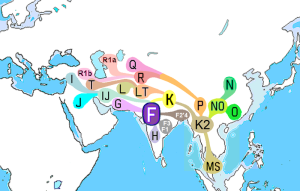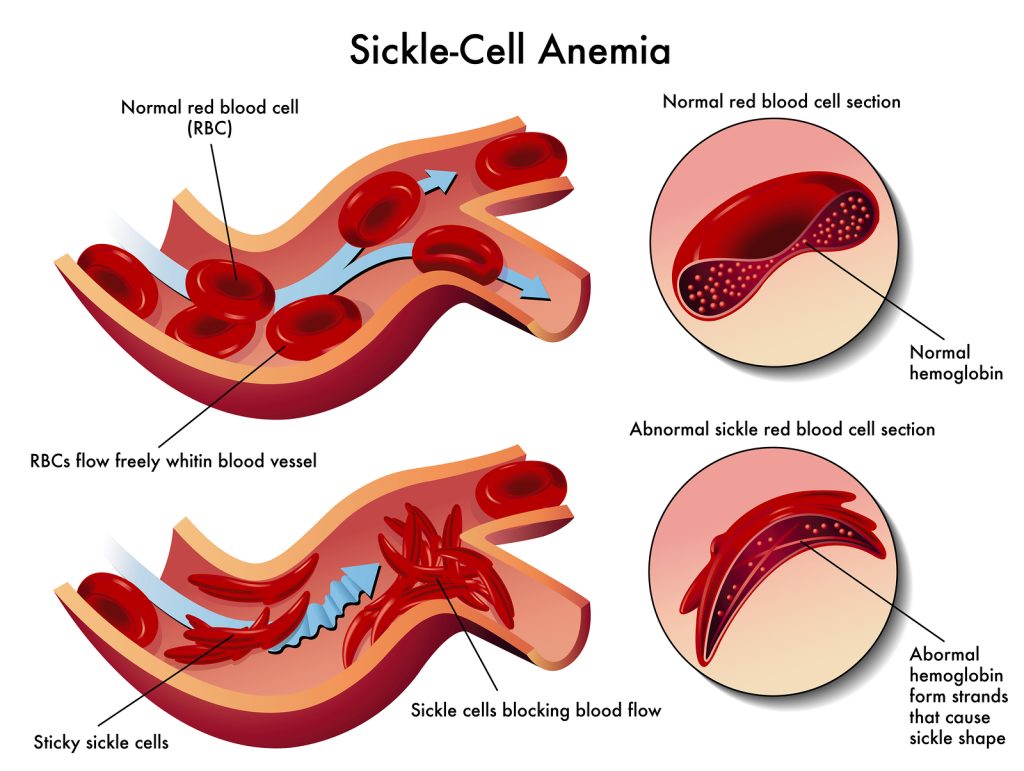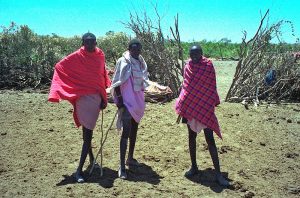7 Human Variation
Michelle Field

Modern Human Variation: The Population Genetics of People
One of the most striking things about humans is the huge range of biological variation we have as a species. In the previous section, we explored the mechanisms of change involved in the evolution of populations (mutation, migration/gene flow, genetic drift, and natural selection). In this section, we’ll look at how those affect human populations to create human diversity.
Polymorphisms
A polymorphism is when a gene has at least two different alleles (and each allele is in more than 1% of the population).
ABO blood type is a perfect example of a polymorphism, which, you will recall, means there are two or more alleles at a locus. In the ABO blood group there are three alleles (A, B, and O) prevalent in most human populations. There are a few populations in the world which are not polymorphic. The O allele occurs in almost 100% of South American indigenous populations and is remarkably high in aboriginal groups in northern Australia. This is most likely due to genetic drift. When alleles vary geographically, they have a clinal distribution. As you can see in the maps below, B is more common in Europe and Asia, and A is found in high numbers in Asia and central Africa.



You can learn more about the ABO blood group from the American Red Cross.
Using Polymorphisms: Clines and Migration

If you know the clinal distribution of a polymorphism, you can use the movement of the alleles as a proxy for the movement of people.
For example, the map below shows the distribution of a group of genes called Haplogroup F (found on the Y chromosome) throughout the Middle East, Europe, and Asia. Presumably the distribution of the genes follow the movement of peoples as they dispersed from India outward.
Natural selection and polymorphisms
While some clinal distributions are due to migration (gene flow), others have been shaped by natural selection.
Lactose tolerance

The original human condition (found in most southern European, Asian, and African populations) is an inability for adults to digest lactose, the primary sugar found in dairy products. This is known as lactose intolerance and it has a genetic basis. Lactose intolerance can be a particularly unpleasant condition for those who consume dairy products and cannot digest them. Symptoms include diarrhea and intestinal gas.
However, some populations of people have developed an ability to digest lactose.
This is how that came about:
- An individual (or individuals) in the population was born with a genetic mutation that allowed them to digest lactose.
- During the same time span, the population was domesticating dairy-producing animals, collecting milk, and consuming it.
- Those who could digest the lactose in the milk (and therefore had a good food source without the unpleasant side effects) had more children than those who could not digest the lactose.
- Those children inherited the gene for lactose tolerance from their parents and passed it down to their children, etc.
This is biocultural coevolution between the domestication of dairy-producing animals in those populations and an increase in the prevalence of the lactose tolerance gene. In other words, the biology of the people was affected by their cultural behaviors and vice versa.
Sickle cell anemia
Sickle cell anemia is a very serious genetic disease that affects the hemoglobin in the blood.

There are two forms of the Hb (hemoglobin) allele: 1) HbA, which is for normal functioning hemoglobin, that which allows red blood cells to carry oxygen efficiently, and 2) HbB (sometimes written as HbS), which is for sickle cell anemia (the hemoglobin and red blood cells do not function normally).
So, as we learned before about alleles and genotypes, when there are two alleles, there are three genotypes. In this case, the genotypes and phenotypes are:
- HbA/HbA = homozygous person has totally normal hemoglobin and their blood transports oxygen perfectly.
- HbA/HbB = heterozygous person has “the sickle cell trait” and therefore is a genetic carrier, but usually has few to no associated medical problems.
- HbB/HbB = homozygous person has sickle cell anemia.
Sickle cell anemia is a good example of the interaction of biology, environment, and culture. It has a fascinating biological interaction with the infectious disease malaria, which in turn is associated with agricultural practices. It has been found that those with sickle cell trait, i.e., people with the HbA/HbB genotype, are less likely to get malaria. Malaria is a disease caused by a parasite, Plasmodium. This life-threatening disease is transmitted through the bites of Anopheles mosquitos. Symptoms include fever, headache, chills, and vomiting. In severe cases, anemia, respiratory distress, or death may occur. Malaria in sub-Saharan Africa is associated with the spread of slash-and-burn agriculture and irrigation.
To recap:
- those with HbA/HbA easily get malaria,
- those with HbB/HbB get sickle cell anemia,
- those with HbA/HbB have protection from malaria and not have sickle cell anemia,
This is called the heterozygote advantage, because the heterozygotes are better off than either one of the homozygotes. It’s this advantage that keeps the HbB allele present in certain populations, which is an example of a balanced polymorphism.
Important note: Remember that this HbB advantage only exists in malarial environments. It is environmentally specific. In an area without malaria, there is no advantage to having the HbB allele and therefore, the frequency of that allele is lower in populations in non-malarial environments.
A little fun with malaria: Malaria the video game
Adaptations and adaptability
Humans have biological plasticity, or an ability to adapt biologically to our environment. An adaptation is any variation that can increase one’s biological fitness in a specific environment; more simply it is the successful interaction of a population with its environment. Adaptations may be biological or cultural in nature. Biological adaptations vary in their length of time, anywhere from a few seconds for a reflex to a lifetime for developmental acclimatization or genetics. The biological changes that occur within an individual’s lifetime are also referred to as functional adaptations. What type of adaptation is activated often depends on the severity and duration of stressors in the environment. A stressor is anything that disrupts homeostasis, which is a “condition of balance, or stability, within a biological system…” (Jurmain et al 2013: 322). Stressors can be abiotic, e.g., climate or high altitude, biotic, e.g., disease, or social, e.g., war and psychological stress. Cultural adaptations can occur at any time and may be as simple as putting on a coat when it is cold or as complicated as engineering, building, and installing a heating system in a building.
Types of Biological Adaptation
Acclimatization
This form of adaptation can take moments to weeks to occur and is reversible within an individual’s lifetime no matter if it occurs when one is a child or an adult.
Short-term acclimatization can occur within seconds of exposure to a stressor. This type of response quickly reverses when the stressor is no longer present. Imagine stepping out of an air-conditioned building or car into a 90 degree day. Your body will quickly begin to perspire in an attempt to cool your body temperature and return to homeostasis. When the temperature declines, so will your perspiration. Tanning is another short-term response, in this case to increased UV-radiation exposure especially during summer months, which can occur within hours. Tans are generally lost during the winter when UV-radiation decreases.
Developmental Acclimatization
Developmental acclimatization occurs during an individual’s growth and development. It’s also called ontological acclimatization or developmental adjustment. Note that these cannot take place once the individual is fully grown. There is usually a “magic time window” of when the acclimatization can occur. This adaptation can take months to years to acquire.
A famous example of this is those who have grown up at high altitude vs. those who have moved to high altitude as adults. Those who were born at high altitude tend to develop larger lung capacities than do those who were not born at high altitude, but moved there later in life. However, developmental adjustment occurs in response to cultural stressors as well. Intentional body deformation has been documented throughout human history. The ancient Maya elite used cradle boards to reshape the skull. Foot binding in China, now an illegal practice, was considered an mark of beauty and enabled girls to find a wealthy spouse.
Genetics
Genetic adaptations can occur when a stressor is constant and lasts for many generations (O’Neil 1998-2013). The presence of the sickle cell allele in some human populations is one example. Keep in mind that genetic adaptations are environmentally specific. In other words, while a particular gene may be advantageous to have in one environment (AKA a genetic adaptation), it may be detrimental to have in another environment.
Human genetic adaptations and human variation
Skin color
Click on this link to watch a fantastic video explaining the interplay of skin color, UV, and vitamin D.
Body size and shape
There are two ecological rules, known as Bergmann’s rule and Allen’s rule, that explain the variation in size and shape of bodies and extremities using latitude and temperature.
Bergmann’s rule: Warm-blooded animals tend to have increasing body size with increasing latitude (toward the poles) and decreasing average temperatures.
Allen’s rule: A corollary of Bergmann’s rule that applies to appendages. Warm-blooded animals tend to have shorter limbs with increasing latitude and decreasing average temperatures
When organisms are more compact, they tend to conserve heat (due to a high mass to surface area ratio). When organisms are more linear, they tend to lose more heat (due to a low mass to surface area ratio).
This has been applied to humans. The idea is that populations toward the pole tend to be shorter and have shorter limbs than do people on the equator. For example, the Inuit people of Canada tend to be shorter than the Maasai people of Kenya.


Race
Technically, a race is a biologically classifiable subspecies. So, when we are asking, “Do human races exist?,” what we’re really asking is, “Are there biologically classifiable subspecies in humans?”
Here’s the American Anthropological Association’s statement on race and the American Association of Physical Anthropologists statement on race.
What are they saying?
Basically:
- race is an arbitrary categorization, races are not biologically distinct groups (in other words, race is a cultural construct, not a biological one)
- while groups of people who have lived together for a long time may have some alleles in common (for example, those that code for skin color or hair color), there is more genetic variation within races than there is between races
- the concept of race has historically been a tool that some people use to subjugate others
Further explore the concept of race, its history, and human variation.
Test Yourself
Can you answer the following questions? If not, reread the chapter.
- What is a polymorphism and how are they related to evolution?
- What does it mean that humans have biological plasticity?
- What are the types of biological adaptation?
- How is skin pigmentation and body shape/size related to biological adaptation?
- What is the race concept and how did it develop over time?
References
Jurmain R, Kilgore L, Trevathan W. 2013. Essentials of physical anthropology, 4th edition. Belmont (CA): Wadsworth, Cengage Learning. 437 p.
Larsen CS. 2008. Our origins: discovering physical anthropology. New York (NY): W.W Norton & Company, Inc. 430 p.
O’Neil D. c1998-2013. Human biological adaptability: an introduction to human responses to common environmental stresses. San Marcos (CA): Palomar College [accessed 2015 June 1]. Available from http://anthro.palomar.edu/adapt/default.htm.
Yoshida-Levine B. c2015. Human variation and adaptation. El Cajon (CA): Grossmont College [accessed 2015 June 1]. Available from http://www.grossmont.edu/people/bonnie-yoshida-levine/online-lectures/human-adaptation.aspx.
Cite this page
APA Style: Field, M. 2022. Human variation. In T. M. Saneda & M. Field, Biological Anthropology: a brief introduction. Cascadia College Pressbooks.
Chicago Style: Field, Michelle. 2022. “Human Variation.” In Biological Anthropology: A Brief Introduction, 3rd. Bothell, WA: Cascadia College Pressbooks.
CSE Style: Field M. 2010. Human variation. In: Biological Anthropology: a brief introduction, 3rd ed. Bothell (WA): Cascadia College Pressbooks. [modified 2022; accessed 2022 Dec 5]. https://openwa.pressbooks.pub/anth205bioanth/chapter/humanvariation.

